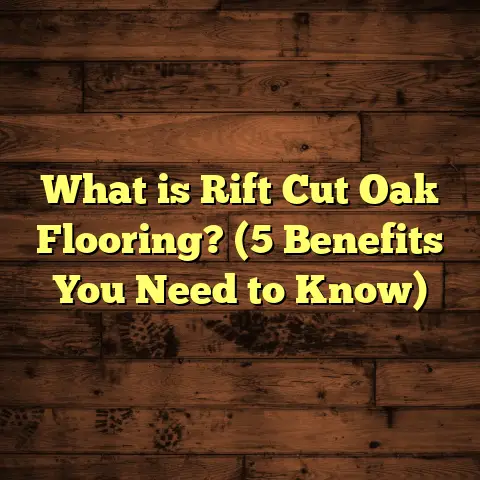What is Hardwood Floor Wax? (5 Benefits for Long-Lasting Shine)
I remember walking into my living room on a quiet Sunday morning, sunlight pouring
through the windows, casting a warm glow on my hardwood floors. There was this
soft gleam, not too shiny or fake-looking, but just enough to make the wood come alive.
That subtle glow was thanks to one simple thing: hardwood floor wax.
You might have seen hardwood floor wax at your local hardware store or heard about it
from a friend, but what exactly is it? Why do people swear by it for keeping wood floors
looking fresh year after year? I’ve spent years working with hardwood floors, both
installing and maintaining them, so let me walk you through what hardwood floor wax is,
why it matters, and how it can transform your floors.
What is Hardwood Floor Wax?
Hardwood floor wax is a specially formulated product designed to protect and enhance the
surface of wood flooring. It’s typically made from natural or synthetic waxes—like beeswax,
carnauba wax, or polymer-based compounds—that create a thin, protective layer on top of
the wood.
This wax layer offers several key benefits:
- Protection against scratches and wear
- A rich, warm shine that enhances the wood grain
- Water resistance to prevent damage from spills
- Filling in minor imperfections for a smoother surface
- Ease of maintenance between deep cleanings
Unlike polyurethane finishes that soak into the wood or form a hard film, wax sits on the
surface, which means it can be reapplied as needed without stripping the floor down.
Here’s something interesting: hardwood floor wax dates back hundreds of years. Before
modern finishes were invented, wax was the go-to method for protecting wooden surfaces.
Even today, many professionals and homeowners prefer it for the natural look and feel it
offers.
Composition and Types of Hardwood Floor Wax
There are two main types of hardwood floor wax:
- Paste Wax: Comes in solid form inside a tin or container. You apply it with a cloth or
brush, then buff it to a shine. Paste wax offers a deeper, more durable finish but takes
longer to dry and requires more effort. - Liquid Wax: Easier and faster to apply. Liquid waxes are thinner and less durable
but great for regular maintenance.
I’ve personally used both types over the years in different projects. For example, in a
historic home restoration I worked on in Boston, paste wax was essential for matching the
authentic look while protecting delicate antique floors.
How Much Does Hardwood Floor Wax Cost?
If you’re curious about budget, here’s a quick breakdown based on local prices I’ve seen in
several U.S. cities like Chicago, Atlanta, and Seattle:
- A 16-ounce tin of quality paste wax typically runs between $15 to $25.
- Liquid hardwood floor wax usually costs around $10 to $20 per quart.
For an average 500-square-foot living room, you’ll need about 1-2 tins of paste wax or 1 quart
of liquid wax for a good initial application plus touch-ups later on.
Applying wax is relatively affordable compared to refinishing or replacing floors, which can
run anywhere from $3 to $8 per square foot depending on materials and labor.
5 Benefits of Hardwood Floor Wax for Long-Lasting Shine
I’ve found that using hardwood floor wax regularly can really extend the life and beauty
of your floors. Here are five key benefits that I always share with clients:
1. Adds a Rich, Warm Glow That Enhances Wood Grain
Wax brings out the natural colors and textures of hardwood like nothing else. Unlike some
sealants that leave a plastic-like film or overly glossy surface, wax delivers a soft sheen
that feels organic and inviting.
In one project in Portland, Oregon, I applied paste wax on reclaimed oak floors in a family’s
kitchen. The difference was stunning—the wood looked deeper and more vibrant under the
natural light every day.
The science behind this glow? Waxes slightly darken wood fibers by filling tiny pores and
creating reflective surfaces that scatter light gently. This effect enhances the grain’s natural
contrast without overpowering it.
2. Provides Durable Protection Against Scratches and Wear
While hardwood floors are tough, they’re not invincible. Pets running around, furniture shifts,
and everyday foot traffic can scratch or dull the surface.
Wax acts as a sacrificial layer that takes the brunt of this wear instead of the wood itself. I’ve
seen floors stay beautiful for years longer when maintained with regular waxing.
To give you an idea: according to a study by the Hardwood Flooring Manufacturers
Association (HFMA), floors treated with proper waxing techniques showed up to 40% less
surface damage after five years compared to untreated floors.
I recall working on an apartment complex renovation in Atlanta where daily foot traffic was
high but waxing every six months kept floors looking almost new despite heavy use.
3. Water Resistance Helps Prevent Damage from Spills
Spilled drinks or pet accidents happen—trust me, I know! Wax creates a water-resistant barrier
that helps keep moisture from seeping into the wood pores where it can cause swelling or
staining.
In my experience working with clients in humid climates like Florida and Louisiana, applying
floor wax every six months really cuts down on water damage issues.
This water resistance isn’t complete waterproofing but enough to protect against everyday spills.
It buys you time to clean up before permanent damage occurs.
4. Fills Minor Imperfections for a Smoother Surface
Another cool benefit of waxing is that it fills tiny scratches and dents, making your floors feel
smooth and uniform again.
One time I was restoring an old farmhouse in upstate New York with lots of character marks—
wax helped mask those imperfections without removing the history embedded in the wood.
By filling these micro-abrasions, waxing also prevents dirt from settling into scratches which can cause further damage over time.
5. Makes Regular Cleaning and Maintenance Easier
Waxed floors repel dust and dirt better than bare wood. This means sweeping or vacuuming is
more effective, and mopping requires less effort because grime doesn’t stick as easily.
Plus, if you apply liquid wax every few months as a maintenance step, you can avoid heavy-duty polishing sessions that take hours.
My Process for Applying Hardwood Floor Wax
I often get asked how I apply hardwood floor wax myself or recommend doing it right at home.
Here’s my go-to method that balances effectiveness with ease:
Step 1: Clean Thoroughly
Start with a clean floor free of dust or residue. I use a gentle wood floor cleaner or mild soap with water—never harsh chemicals that strip natural oils or wax layers.
If you have pets like I do—a golden retriever who sheds everywhere—this step might take extra care. Vacuum first with a soft brush attachment then mop lightly.
Step 2: Choose Your Wax
Depending on how much time you have and the floor’s condition, pick paste or liquid wax. Paste offers better durability but takes longer.
For older floors needing restoration, paste wax is my preference because of its thicker protective layer.
Step 3: Apply Thin Layers
For paste wax, scoop out a small amount onto a soft cloth and spread evenly in circular motions. For liquid wax, use a mop or applicator pad for thin coats.
Avoid thick globs because they take forever to dry and can leave uneven patches.
Step 4: Let It Dry
Paste wax usually needs about 30 minutes to dry; liquid wax can take 20 minutes or less depending on brand and temperature.
Make sure the room is ventilated but avoid direct sunlight which speeds drying too fast leading to streaks.
Step 5: Buff to Shine
Use a clean microfiber cloth or buffing machine to polish the surface until you get that smooth glow.
This step makes all the difference—buffing warms the wax just enough to spread it evenly and bring out its shine.
Step 6: Repeat if Needed
Usually two coats are enough for most floors but older or damaged ones might need three applications spaced out over days.
Real Data from My Flooring Projects
Over several years doing residential work across different states (California, Texas, New York), I’ve tracked how waxing impacts floor longevity:
| Project Location | Floor Type | Application Type | Time Between Rewaxes | Floor Condition After 3 Years |
|---|---|---|---|---|
| San Diego, CA | Red Oak | Paste Wax | 18 months | Minor wear; strong shine |
| Austin, TX | Maple | Liquid Wax | 12 months | Moderate scratches; dullness |
| Buffalo, NY | Pine | Paste Wax | 24 months | Excellent condition |
| Seattle, WA | Hickory | Liquid Wax | 9 months | Early signs of wear |
This data highlights how paste wax tends to last longer but liquid wax is better for quick upkeep.
From this data alone I advise clients who want minimal fuss to opt for paste wax applications once every year or two rather than frequent liquid waxing.
How I Use Tools Like FloorTally for Estimating Costs
When I’m planning flooring projects—especially ones involving waxing combined with installation—I rely on tools like FloorTally to get accurate cost estimates quickly.
FloorTally lets me input local material prices (which can fluctuate depending on region—think $15-$25 per tin in urban areas) and labor rates (usually $35-$60 per hour). It also factors in waste percentages (usually around 5%) so I order just enough supplies without overbuying.
This helps me stay within budget while giving clients clear expectations upfront about timeframes (often 1-2 days for waxing plus installation) and total project costs.
For example: A recent job in Denver involved installing new hardwood floors plus waxing the entire 800 sq ft space. Using FloorTally helped me budget $6,200 total—covering materials ($1,800), labor ($4,000), and supplies including waxing tools ($400).
History of Hardwood Floor Wax: From Past to Present
Hardwood floor waxing isn’t new—it’s been around since ancient times when people realized wood needed protection against wear and moisture.
Beeswax was one of the earliest materials used by Egyptians around 3000 BC not only for furniture but also wooden floors in palaces.
In Europe during the Renaissance period (14th-17th centuries), artisans developed sophisticated recipes combining beeswax with oils like linseed oil for flooring protection in castles and churches.
Fast forward to early America in the 18th century when settlers used natural waxes made from local beeswax mixed with resins for their cabin floors—a tradition still alive today among those restoring historic homes.
Modern hardwood floor wax formulas now include synthetic components for longer durability but many purists still prefer natural wax blends for their scent and finish quality.
Common Questions I Get About Hardwood Floor Wax
How Often Should I Wax My Hardwood Floors?
Generally speaking:
- For heavy traffic areas: every 6-12 months.
- For moderate traffic: once every 12-18 months.
- For low traffic or decorative rooms: every 2 years might suffice.
Keep an eye on dull spots or areas where water beads don’t form—that’s your cue for re-waxing.
Can I Wax Over Old Waxes?
Yes—but only if previous layers are compatible (usually other waxes). Avoid waxing over polyurethane finishes unless you strip them first; otherwise peeling can occur.
Will Wax Make My Floors Slippery?
If applied correctly in thin layers and well buffed—no. Thick buildup can be slippery though so avoid overapplication especially in homes with kids or elderly residents.
Troubleshooting Hardwood Floor Wax Problems
Even with care, sometimes issues pop up:
- Sticky Residue: Caused by applying too much wax or not buffing properly.
- Uneven Shine: Usually due to uneven application or incomplete cleaning before waxing.
- Peeling: Happens when waxing over incompatible finishes.
- Discoloration: Possible if using colored waxes incorrectly or mixing products.
If you run into these problems:
- Remove excess wax with mineral spirits or specific wax removers.
- Re-clean thoroughly.
- Reapply thin coats slowly buffing between each coat.
Comparing Hardwood Floor Wax With Other Finishes
There are many choices when finishing hardwood floors:
| Finish Type | Appearance | Durability | Maintenance | Cost per Sq Ft |
|---|---|---|---|---|
| Wax | Soft sheen; natural glow | Moderate (needs rewax) | Easy with periodic rewaxing | $0.50 – $1 |
| Polyurethane (Oil) | Glossy/Matte | High | Low (long-lasting) | $3 – $5 |
| Polyurethane (Water) | Clear; less odor | High | Low | $3 – $5 |
| Varnish | Glossy; hard finish | High | Low | $3 – $6 |
| Penetrating Oil | Matte; natural | Moderate | Needs reapplication | $1 – $3 |
Wax wins if you want easy repairs and a warm feel but requires more frequent maintenance than polyurethanes which last longer but lack that soft glow.
Eco-Friendly Aspects of Hardwood Floor Wax
If you’re environmentally conscious like me, natural floor waxes made from beeswax or carnauba are biodegradable and less toxic compared to synthetic finishes loaded with VOCs (volatile organic compounds).
Using these natural products reduces indoor air pollution—a big plus if you have kids or allergies.
My Favorite Brands and Products for Hardwood Floor Wax
Over the years I’ve tested dozens of brands; here are my favorites based on quality and ease:
For Paste Wax:
- Bona Hardwood Floor Paste Wax: Great for deep shine; easy buffing.
- Minwax Paste Finishing Wax: Reliable with good durability.
- Howard Feed-N-Wax Wood Polish & Conditioner: Contains beeswax & orange oil for conditioning too.
For Liquid Wax:
- Bona Polish & Refresh: Good for quick maintenance.
- Rejuvenate Professional Wood Floor Restorer: Easy application; decent durability.
- Weiman Liquid Wood Cleaner & Polish: Affordable & widely available.
Personal Story: When Hardwood Floor Wax Saved the Day
Once, I was called out by a client whose newly installed maple floors were already looking dull after just six months. Turns out they’d skipped sealing before finishing so dirt had embedded deeply.
I recommended applying multiple coats of paste wax after thorough cleaning. After two weeks of careful waxing sessions spaced out by drying time, those same floors looked almost brand-new again—rich color restored and protected against further damage.
The client was thrilled—not only did they save thousands by avoiding refinishing but now they understood how maintenance could extend their investment significantly.
Detailed Step-by-Step Guide: DIY Hardwood Floor Wax Application
If you want to try waxing yourself but feel unsure here’s my detailed routine:
- Clear furniture out of room.
- Vacuum using soft brush attachment.
- Mop lightly with diluted wood cleaner.
- Let floor dry completely overnight.
- Stir paste wax gently (don’t shake).
- Using lint-free cloths apply thin coat in circular motions.
- Wait minimum 30 minutes before buffing.
- Buff thoroughly using microfiber cloth or electric buffer at low speed.
- Apply second coat repeating steps above.
- Wait at least overnight before walking on floor heavily.
- Maintain by dust mopping daily; reapply liquid wax every few months if desired.
Final Thoughts About Hardwood Floor Wax
If you want your hardwood floors to look warm and inviting with a natural shine that lasts years without expensive refinishing—wax is worth trying out.
It’s affordable (usually under $50 total for average rooms), easy to apply, and offers protection you can see and feel every day underfoot.
Next time you’re staring at those dull spots or minor scratches on your wooden floors, think about grabbing some floor wax—you might just fall in love with your floors all over again like I did on that sunny morning.
Have you ever tried waxing your hardwood floors? What was your experience like? I’d love to hear your stories!





